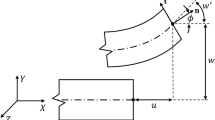Abstract
Based on Kirchhoff's hypothesis and relevant variational principles, this work presents an assumed hybrid-dis-placement finite element model to solve the bending problems of thin cracked plates subjected to static and dynamic loadings. To provide a potential method of non-destructive testing in evaluating the integrity of structure, natural vibrations of the thin cracked plate are also studied. Since the integrand of the associated functional contains the second-order derivatives of the lateral displacement of the plate, the compatibility requirements for the lateral displacement and its normal slope at inter-element boundaries are enforced in an integral sense through the use of a Lagrangian multiplier technique. The proper singular behaviours for the bending stresses and strains are incorporated in the singular elements around the crack-tips. The static and dynamic symmetric and anti-symmetric bending stress intensity factors can be directly computed. To avoid underestimation of dynamic bending stress intensity factors, the important role of the singular elements is also demonstrated. Good correlations between the computed results and available solutions in the literature show the accuracy and efficiency of the present work. Some new solutions for the bending thin cracked plates are then drawn.
Résumé
En se basant sur I'hypothèse de Kirchoff et sur des principes adéquats d'adaptation, on présente dans ce travail un modèle par éléments finis à déplacements hydrides qui est supposé résoudre les problèmes de flexion de tôle mince soumise à des charges statiques et dynamiques. On a également étudié les vibrations naturelles de la tôle mince fissurée en vue d'établir une méthode potentielle d'essai non destructif pour évaluer l'intégrité de la structure. Comme l'intégrant de la fonction associée comporte des dérivées du second ordre du déplacement latéral de la tôle, les exigences de compatibilité pour le déplacement latéral et pour la pente normale à la liaison entre les éléments sont contenues dans un sens intégral en utilisant la technique des multiplicateurs de Lagrange. Les comportements singuliers relatifs aux contraintes et aux déformations de flexion sont incorporés dans les éléments singuliers au voisinage des pointes de la fissure. Il est possible de calculer directement les facteurs d'intensité de contraintes symétriques et antisymétriques, qu'ils soient statiques ou dynamiques. En vue d'éviter une sous-estimation des facteurs d'intensité de contrainte en flexion dynamique, on démontre également le rôle important des éléments singuliers. La précision et l'utilité de ce travail sont démontré par les bonnes corrélations obtenues entre les résultats calculés et les solutions disponibles dans la littérature. Quelques solutions nouvelles relatives à la flexion de tôle mince fissurée sont ensuite présentées.
Similar content being viewed by others
References
O.C. Zienkiewicz, The Finite Element Method, 3rd edition, Mcgraw-Hill (1977).
P. Tong, and T.H.H. Pian, International Journal of Solids and Structures 9 (1973) 313–321.
P. Tong, International Journal for Numerical Methods in Engineering 2 (1970) 73–83.
S.N. Atluri, A.S. Kobayashi and M. Nakagaki, International Journal of Fracture 11 (1975) 257–271.
S.N. Atluri, M. Nakagaki and W.H. Chen, Pressure Vessel Technology, New York: ASME (1977) 579–593.
S.N. Atluri, M. Nakagaki and W.H. Chen, in Flaw Growth and Fracture, ASTM STP 631 (1977) 42–61.
S.N. Atluri, M. Nakagaki and W.H. Chen, in Numerical Methods in Fracture Mechanics (1978) 52–66.
S.N. Atluri, M. Nakagaki and W.H. Chen, in Elastic-plastic Fracture, ASTM STP 668 (1979) 195–213.
W.H. Chen and Y.H. Huang, International Journal of Fracture 15 (1979) R73–76.
W.H. Chen and C.W. Wu, International Journal of Fracture 16 (1980) R47–51.
W.H. Chen and C.H. Wang, Engineering Structures 3 (1981) 249–255.
W.H. Chen and C.W. Wu, Engineering Fracture Mechanics 15 (1981) 155–168.
W.H. Chen and K.T. Chen, International Journal of Fracture 17 (1981) R99–103.
W.H. Chen and Y.H. Huang, Journal of the Chinese Society of Mechanical Engineers 1 (1980) 21–32.
W.H. Chen and T.C. Lin, Engineering Fracture Mechanics 18 (1983) 133–143.
M.L. Williams, Journal of Applied Mechanics 28 (1961) 78–82.
R. Roberts and T. Rich, Journal of Applied Mechanics 34 (1967) 777–779.
L.M. Keer and C. Sve, International Journal of Solids and Structures 6 (1970) 1545–1559.
B. Stahl and L.M. Keer, International Journal of Solids and Structures 8 (1972) 69–91.
H.C. Rhee, Ph.D. Thesis, Georgia Institute of Technology (1976).
S. Timoshenko and S. Woinowsky-Krieger, Theory of Plates and Shells, 2nd edn., McGraw-Hill (1959).
K.H. Huebner, The Finite Element Method for Engineers, 1st edn., Wiley-Sons (1975).
B.M. Irons and K.J. Draper, A.I.A.A. Journal 3 (1965) 961.
F.K. Bogner, R.L. Fox and L.A. Schmit, in Proceedings Conference Matrix Methods in Structural Mechanics, Wright Patterson Air Force Base, Ohio (1965) 397–443.
S. Gopalacharyulu, International Journal for Numerical Methods in Engineering 6 (1973) 305–309.
K. Bathe and E.L. Wilson, Numerical Methods in Finite Element Analysis, 1st edn., Prentice-Hall (1976).
L. Meirovitch, Analytical Methods in Vibrations, 1st edn., Collier-Macmillan (1967).
M.D. Waller, Proceedings of the Physical Society of London 51 (1939) 831–844.
Author information
Authors and Affiliations
Rights and permissions
About this article
Cite this article
Chen, W.H., Chen, P.Y. A hybrid-displacement finite element model for the bending analysis of thin cracked plates. Int J Fract 24, 83–106 (1984). https://doi.org/10.1007/BF00028054
Received:
Issue Date:
DOI: https://doi.org/10.1007/BF00028054



